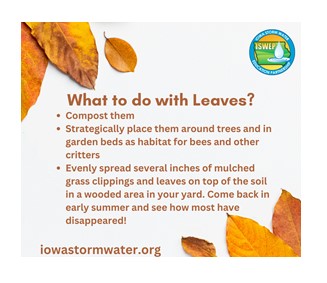Stormwater Management
Stormwater Management
Stormwater Management is an ongoing process in our Community. The City of Ely is a member of the Iowa Stormwater Education Partnership (ISWEP) and is a MS4 City. There are things we all can do to help reduce the amount of stormwater pollutants and runoff that impact our local waterways.The public plays an active role in helping keep stormwater clean. The best way to protect our water sources through stormwater management is to limit what enters storm sewers and waterways. The public is warned against dumping anything but rainwater into storm sewers. Dumping hazardous materials into the storm drainage system is illegal.
The intent of the federal stormwater regulation is to improve water quality by reducing or eliminating contaminants in stormwater. Stormwater is defined as precipitation runoff, surface runoff and drainage, street runoff, and snow melt runoff. Contaminants have the potential to effect additional downstream receiving waters. Contaminants introduced in stormwater runoff or into storm sewers may impact drinking water sources, waters protected for recreation, waters protected for aquatic life as well as other beneficial uses.
Effective stormwater management provides environmental, social, and economic benefits to communities. When stormwater management is done well, streams, rivers, and lakes are cleaner; flood risks are reduced; costs due to flood damage decrease; and quality of life increases.
Helpful Links
For additional resources on managing stormwater, visit the following resources:
- Stormwater Management
- Avoid Drain Backups
- Residential Lawn Care Flyer
- Food Waste, Oil and Grease Disposal
- Illicit Discharge Draining Pools
- Rainscaping Iowa
- Rainscaping Iowa: Pollution Prevention for Homeowners
- Construction Site Pollution Prevention
Tips to Prevent Stormwater Pollution 
- Bag your pet’s waste. Leaving pet waste on the ground increases public health risks by allowing harmful bacteria and nutrients to wash into the storm drain and eventually into local water-bodies.
- Don’t apply pesticides, fertilizers and herbicides before heavy rain. Contrary to popular belief, the rain won’t help to soak these chemicals into the ground; it will only help create polluted runoff into our local creeks.
- Select native and adapted plants and grasses that are drought and pest resistant. Native plants require less water, fertilizer, and pesticides.
- Reduce the amount of paved area and increase the amount of vegetated area in your yard.
- Don’t dump motor oil or auto fluids on the ground or in the storm drain; dispose of it properly at an oil recycling center.
- Check your car, boat, or motorcycle for leaks. Clean up spilled fluids with an absorbent material, don’t rinse the spills into the storm drain.
- Don’t get rid of grass clippings and other yard waste by dumping it or sweeping it into the storm drain; this will cause depleted oxygen for aquatic life. Instead, compost your yard waste.
- When washing your car at home, wash with only water or use biodegradable soap and wash it on a lawn or other unpaved surface.
- Don’t get rid of old or unused paint by throwing it down the storm drain; dispose of paint and other household hazardous waste at recycling facilities.
- Don’t pump your pool water into the storm drain; pool chemicals can be hazardous to our creek habitats.
- Throw litter away in a garbage can; not in the ditches. Storm drains, culverts and ditches are intended for rain water and snow melt only

